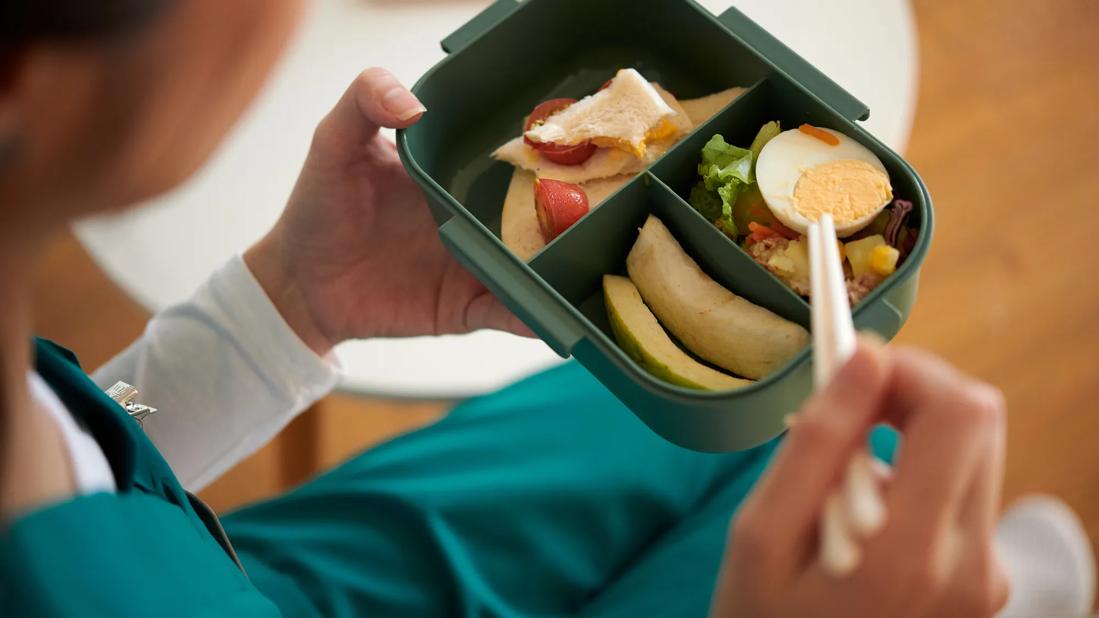A circulating nurse takes over for caregivers on lunch

During leadership rounding in late 2017, a clinical nurse in the ICU at Cleveland Clinic Lutheran Hospital shared with Chief Nursing Officer Janet Schuster, DNP, MBA, RN, NEA-BC, CPHQ, HACP, and other leaders that it was often difficult to take lunch breaks on the 10-bed unit with only two RNs working per shift. When the leadership team convened after rounding to consider all the feedback, they knew this was a top priority to address.
Advertisement
Cleveland Clinic is a non-profit academic medical center. Advertising on our site helps support our mission. We do not endorse non-Cleveland Clinic products or services. Policy
“The job of caring for patients can be stressful. Nurses look forward to lunches and other breaks to walk away, get time off the unit and clear their heads,” says Monica Bender-Walker, MS, BSN, RN, Director of Nursing for Behavioral Health at Lutheran Hospital. “They need to take lunch breaks not just for their employee engagement, but for their well-being and that of their patients.”
Bender-Walker and Katrina Hartig, MS, BSN, RN, NE-BC, Director of Nursing for Inpatient and Emergency Services, examined the problem of missed lunch breaks and devised a solution for the 203-bed acute care hospital, which has several small units.
One of the first steps taken by Bender-Walker was to ask caregivers in two 10-bed units that she oversees – the mood disorder clinic and the non-acute adult behavioral health unit – if they experienced the same problem as the ICU nurses. They did. Nurses in all the small units were uncomfortable taking breaks, thereby leaving only one RN on duty in their absence. Instead, they remained on the unit for lunch or skipped the break altogether.
Not only did this lead to decreased job satisfaction and potential safety concerns, but it also had financial implications. At the end of their shifts, nurses who did not take lunches were clocking out using the “meal cancellation” notation to prevent the automatic timekeeping system from deducting a half-hour of ages. During the fourth quarter of 2017, nurses on four units utilized the meal cancellation notation a total of 88 times. This, in turn, led to the hospital incurring incidental overtime charges.
Advertisement
Bender-Walker and Hartig took a close look at financial information, as well as staffing tables. They considered adding a position to nurse staffing within the existing full-time equivalent (FTE) allocation, but discovered it would affect nursing hours per patient day. So Bender-Walker and Hartig met with Lutheran Hospital’s finance manager to discuss ways to minimize the fiscal impact of providing coverage for nurses on breaks. Together, they developed a position called “the circulator.”
While the nursing team couldn’t add an employee or FTE to a unit, it was able to carve out hours from each of the four 10-bed units that required lunch coverage – the ICU, the mood disorder clinic, the non-acute adult psychology unit and a general surgery unit. For instance, one unit had a part-time position that had been open for a year. It opted not to fill the position. All the units had PRN positions that they decided to forgo. “We found a way to take some tidbits from each unit’s FTEs and create a space for a full-time caregiver to relieve other nurses during their lunches and breaks,” says Bender-Walker.
The nursing directors allocated 0.3 FTEs to each shift whose census only permitted two caregivers. That allowed for a full-time caregiver to circulate each day among the four units and provide coverage for lunches and breaks. These circulators are existing, trained department staff who can complete all nursing care tasks within their scope of practice. “They aren’t given a patient assignment, and they don’t assume care of the patient,” says Bender-Walker. “They function as a helping hand.”
Advertisement
Each day, the nursing operations manager comes up with a proposed schedule for the circulator, checking in with units about their staffing, patient acuity, ideal times for breaks and other pertinent information. Staffing is assessed every four hours, and circulators may be assigned to a four- or eight-hour shift, depending on requirements for the day and the nurse’s preference.
After the circulator role was implemented, meal cancellation occurrences dropped to 41 in the second quarter of 2018, a decrease of 53% from the quarter prior to the intervention. “It’s cut down on our incremental overtime,” says Bender-Walker. “It’s also been a big employee satisfier. Being able to take lunches helps the nurses manage stress on the job.”
As an added bonus, many nurses have been pleasantly surprised at how much they enjoy the circulator role. Rather than being intimidated by working on different units, they enjoy the variety. “Implementing the circulator has been a win for everybody,” says Bender-Walker.
Advertisement
Advertisement

Nurses harness cutting-edge technology as a bridge to healing

Project aims to improve patient care by streamlining caregiver transitions

Optimizing care while protecting patients from life-threatening reactions

Palliative nurses improve quality of life

Strong bonds and momentous milestones fuel life-changing work

Experts offer hands-on support and education

Special skills course aims to improve patient safety and comfort while building caregiver confidence

Bariatric nurses deliver sensitivity, compassion and skill